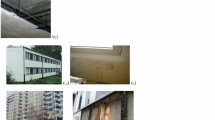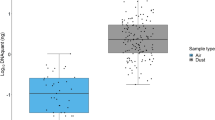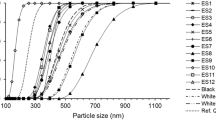Abstract
The collapse of the World Trade Center (WTC) towers on September 11, 2001, caused lower Manhattan and adjacent areas to be covered in millimeters to centimeters of dust. WTC dust penetrated into indoor spaces, and public health concerns remain regarding exposure to possible residual dust in the affected areas. The goal of the studies outlined in this review was to determine which, if any, components of the bulk WTC dust are sufficiently above typical background dust levels in New York City to develop an analytical method to screen for the component(s). Components of the <150-μm-size fraction of the dust are gypsum, phases compatible with crushed concrete, man-made vitreous fibers (MMVFs), silica, lead, chrysotile asbestos, and other materials. Slag wool was the most common WTC MMVF, whereas soda-lime glass and rock wool were minor to trace constituents. Most background samples also contained gypsum, phases compatible with concrete, and MMVF. However, the proportions of the various MMVF in background samples are typically unlike those characteristic of bulk WTC dust. Results indicate that slag wool can be used as a signature marker to identify areas that contain potential residual WTC dust contamination at concentrations that are less than average background levels for the material.
This is a preview of subscription content, access via your institution
Access options
Subscribe to this journal
Receive 6 print issues and online access
$259.00 per year
only $43.17 per issue
Buy this article
- Purchase on Springer Link
- Instant access to full article PDF
Prices may be subject to local taxes which are calculated during checkout



Similar content being viewed by others
References
Badger S.R., Rickabaugh K.P., Potter M.S., Scheetz B.E., Bhattacharjee H.R., and Lee R.J. World Trade Center particulate contamination signature based on dust composition and morphology. Microsc. Microanal. 2004: 10 (suppl. 2): 948–949.
Banauch G.I., Dhala A., Alleyne D., Alva R., Santhyadka G., Krasko A., et al. Bronchial hyperreactivity and other inhalation lung injuries in rescue/recovery workers after the World Trade Center collapse. Crit. Care Med. 2005: 33: S102–S106.
Brackbill R.M., Thorpe L.E., DiGrande L., Perrin M., Sapp II J.H., Wu D., et al. Surveillance for World Trade Center disaster health effects among survivors of collapsed and damaged buildings. MMWR Surveill. Summ. 2006: 55: 1–18.
Centers for Disease Control and Prevention. Physical health status of World Trade Center rescue and recovery workers and volunteers. New York City July 2002 to August 2004 MMWR 2004: 53: 807–812.
Chatfield E.J., and Kominsky J.R. Characterization of Particulate Found in Apartments after Destruction of the World Trade Center. Chatfield Technical Consulting Limited, Mississauga, Ontario, Canada, 2002.
Clark R.N., Green R.O., Swayze G.A., Meeker G.P., Sutley S., Hoefen T.M., et al. Environmental studies of the World Trade Center area after the September 11, 2001 attack. US Geol. Surv. Open File Report 01-0429 2001.
Gavett S.H., Haykal-Coates N., Highfill J.W., Ledbetter A.D., Chen L.C., Cohen M.D., et al. World Trade Center fine particulate matter causes respiratory tract hyperresponsiveness in mice. Environ. Health Perspect. 2003: 111: 981–991.
Herbert R., Moline J., Skloot G., Metzger K., Baron S., Luft B., et al. The World Trade Center disaster and the health of workers: five-year assessment of a unique medical screening program. Environ. Health Perspect. 2006: 114 (12): 1853–1858; doi:10.1289/ehp.9592.
International Organization for Standardization 14966. Ambient air — determination of numerical concentration of inorganic fibrous particles — scanning electron microscopy method, 2002.
Lioy P.J., Weisel C.P., Millette J.R., Eisenreich S., Vallero D., Offenberg J., et al. Characterization of the dust/smoke aerosol that settled east of the World Trade Center (WTC) in lower Manhattan after the collapse of the WTC 11 September 2001. Environ. Health Perspect. 2002: 110: 703–714.
Lowers H.A., and Meeker G.P. Particle atlas of WTC dust. US Geol. Surv. Open File Report 2005-1165 2005.
Lowers H.A., Meeker G.P., and Brownfield I.K. Analysis of background residential dust for World Trade Center signature components using scanning electron microscopy and x-ray microanalysis. US Geol. Surv. Open File Report 2005-1073 2005.
McGee J.K., Lung C.C., Cohen M.D., Chee G.R., Prophete M.P., Haykal-Coates N., et al. Chemical analysis of World Trade Center fine particulate matter for use in toxicologic assessment. Environ. Health Perspect. 2003: 111: 972–980.
Meeker G.P., Bern A.M., Lowers H.A., and Brownfield I.K. Determination of a diagnostic signature for World Trade Center dust using scanning electron microscopy point counting techniques. US Geological Survey Open File Report 2005-1031 2005a. Accessible at http://pubs.usgs.gov/of/2005/1031/OF2005_1031_508.pdf.
Meeker G.P., Sutley S.J., Brownfield I.K., Lowers H.A., Bern A.M., Swayze G.A., et al. Materials characterization of dusts generated by the collapse of the World Trade Center, in urban aerosols and their impacts: lessons learned from the World Trade Center tragedy. A.C.S. Symp. Ser. 2005b: 919: 84–102.
Millette J.R., Boltin R., Few P., and Turner Jr W. Microscopical studies of World Trade Center disaster dust particles. Microscope 2002: 50: 29–35.
Offenberg J.H., Eisenreich S.J., Chen L.C., Cohen M.D., Chee G., Prophete C., et al. Persistent organic pollutants in the dusts that settled across lower Manhattan after September 11, 2001. Environ. Sci. Tech. 2003: 37: 502–508.
Prezant D.J., Weiden M., Banauch G.I., McGuinness G., Rom W.N., Aldrich T.K., et al. Cough and bronchial responsiveness in firefighters at the World Trade Center site. New Eng. J. Med. 2002: 347: 806–842.
Rosati J.A., Bern A.M., Willis R.D., Blanchard F.T., Conner T.L., Kahn H.D., and Friedman D. Multi-laboratory testing of a screening method for world trade center (WTC) collapse dust. Sci. Total Environ. 2008: 390: 514–519.
Swayze G.A., Clark R.N., Sutley S.J., Hoefen T.M., Plumlee G.S., Meeker G.P., et al. Spectroscopic and x-ray diffraction analyses of asbestos in the World Trade Center dust, in urban aerosols and their impacts: lessons learned from the World Trade Center tragedy. A.C.S. Symp. Ser. 2005: 919: 40–65.
TIMA (Thermal Insulation Manufacturers Association). Nomenclature of Man-Made Vitreous Fibers. TIMA Inc., Stamford, CT. 1991.
US Environmental Protection Agency Final Report on the World Trade Center (WTC) Dust Screening Study August 17, 2005: http://www.epa.gov/wtc/panel/pdfs/Final_Report_August_17_2005.pdf.
US Environmental Protection Agency (EPA) US EPA Response to the “Peer Review of the US Environmental Protection Agency's Final Report on the World Trade Center (WTC) Dust Screening Study” Appendix : A Expanded Statistical Evaluation of Slag Wool Data, December. 2006: http://www.epa.gov/wtc/panel/pdfs/appendix-a-final-summary-dec2006.pdf.
Yiin L., Millette J.R., Vette A., Ilacqua V., Quan C., Gorczynski J., et al. Comparisons of the dust/smoke particulate that settled inside the surrounding buildings and outside on the streets of southern New York City after the collapse of the World Trade Center, September 11, 2001. J. Air Waste Management Assoc. 2004: 54: 515–528.
Acknowledgements
We acknowledge the outstanding work of Jacky Rosati in conducting the EPA signature study and Amy Bern and others at USEPA for their method development. We also thank Edward du Bray and Sharon Diehl, USGS, for their insightful reviews. The contributions of Dr. Lippmann were supported, in part, by Center Grant ES 00260 from the National Institute of Environmental Health Sciences (NIEHS), and Dr. Lioy was supported in part by a Center Grant ES 05022 from NIEHS.
Author information
Authors and Affiliations
Corresponding author
Rights and permissions
About this article
Cite this article
Lowers, H., Meeker, G., Lioy, P. et al. Summary of the development of a signature for detection of residual dust from collapse of the World Trade Center buildings. J Expo Sci Environ Epidemiol 19, 325–335 (2009). https://doi.org/10.1038/jes.2008.25
Received:
Accepted:
Published:
Issue Date:
DOI: https://doi.org/10.1038/jes.2008.25
Keywords
This article is cited by
-
A novel system to generate WTC dust particles for inhalation exposures
Journal of Exposure Science & Environmental Epidemiology (2014)
-
Comment on: “Summary of the development of a signature for the detection of residual dust from collapse of the World Trade Center buildings”
Journal of Exposure Science & Environmental Epidemiology (2010)



